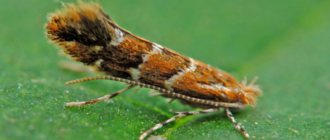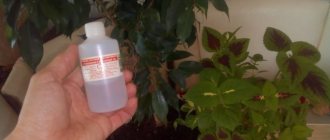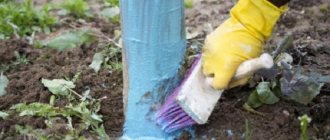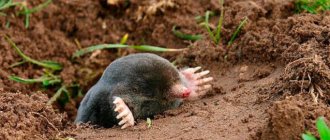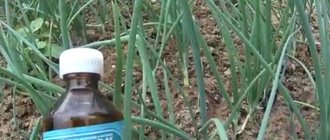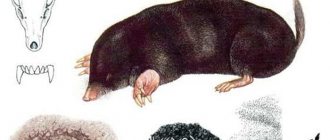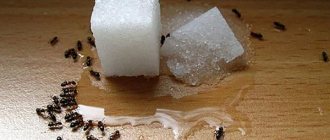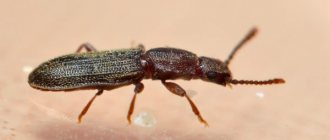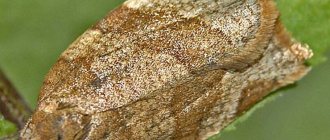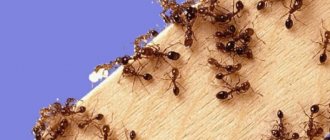Pests of fields, gardens and vegetable gardens
This group includes many species of insects from different orders:
- locusts and mole crickets (orthoptera);
- Lepidoptera caterpillars;
- Diptera larvae;
- aphids and psyllids (homoptera);
- bedbugs (hemiptera);
- beetles (coleoptera);
- sawflies (hymenoptera).
Particularly harmful lepidoptera:
- the codling moth, whose caterpillar lives in apples;
- cutworms, whose caterpillars eat grain seedlings;
- silkworms, whose caterpillars completely eat the leaves, denuding the trees.
Among the beetles, the following are especially dangerous:
- click beetles, the larvae of which are called wireworms and gnaw the roots of plants;
- weevils that damage vegetables and garden trees;
- leaf beetles, which include the Colorado potato beetle and garden flea beetles.
Rice. 1. Insects are garden pests.
Folk remedies for fighting butterflies
You can also destroy or repel garden pest butterflies using harmless homemade products.
| Means | Mode of application |
| Hemp, calendula, thyme | Plants are planted under fruit trees; Butterflies are repelled by the strong smell. |
| Composition of salt and shag | Spray the fruit trees with an aqueous solution (800 g of table salt and 400 g of shag are combined with 10 liters of water, infused for 24 hours). |
| Yarrow decoction | Dry grass (250 g) or fresh plants (200 g) are poured with 2 liters of water, after boiling, cook for another 5 minutes, cool and strain. Add water to 10 liters and spray. |
| Infusion of dry calendula and garlic seeds | Finely chop or crush 100 g of garlic and mix with 4 cups of flower seeds. Infuse the mixture in a bucket of cold water for 3 hours. Spray plants after sunset. A month before harvest, stop using the mixture. |
| Decoction and infusion of wormwood | Chop 3 kg of fresh (600 g dry) herbs, leave for 24 hours in 10 liters of cold water, then boil for another 30 minutes. Grind 5 cups of fresh herbs, pour 10 liters of boiling water and leave for 3 hours. The last treatment of plants with wormwood preparations is 1 month before harvest. |
Fighting methods
Losses from insect pests are enormous, so people fight against them in order to preserve the harvest, health and material values. All methods of struggle are divided into:
- mechanical;
- chemical;
- biological;
- agrotechnical.
Mechanical control measures
This is the collection and destruction of insects at different stages of their development.
These measures are effective on small crop areas.
Biological control measures
Their essence is the use of entomophages - insects that are enemies of harmful insects. Entomophages are bred in biological laboratories and released into the fields.
Chemical control measures
Substances that kill insects are called insecticides. Their treatment is effective and is carried out over large areas of fields and gardens. The negative side of these measures is that beneficial insects also die:
- pollinators;
- entomophages;
- soil formers.
Rice. 3. Treating the field with insecticides.
Agrotechnical control measures
These include:
- control of weeds as a breeding ground for pests;
- use of pest-resistant varieties;
- alternation of crops in crop rotation.
Integrated application of control measures is less expensive and more effective than any single method.
Video: Garden pests
Goldentail
Actually, it is not butterflies that cause harm, but their caterpillars . In addition to fruit trees, it damages oak and some other tree species. This is a snow-white moth, with a golden tuft of dense hairs at the end of the abdomen; wingspan is up to 4 cm. Adult caterpillars grow up to 3.5 cm. Against the general grayish-black background of the body, chains of red warts with protruding tufts of yellowish-brown hairs stand out sharply. There are white intermittent stripes on the sides, 2 red-brown stripes on the back, and 2 orange spots at the end of the body. In disturbed caterpillars, orange spots protrude and secrete a toxic liquid that dries on the hairs in the form of a powder. When broken off hairs come into contact with human skin, they cause itching, redness and swelling, and sometimes headaches and coughing. You can relieve skin irritation using soda compresses (1 teaspoon of baking soda per 200 ml of water). Caterpillars overwinter in nests made of dry leaves, tightly attached to the forks of branches with cobwebs. Each nest contains from 200 to 2000 caterpillars. Their release in the spring coincides with the beginning of swelling and bud opening .
About 2 weeks after the end of fruit flowering, the caterpillars make small cobwebby cocoons and turn into pupae. Cocoons can be found in rolled leaves, on bark, and in the forks of branches. Usually butterflies appear in the second half of June. They are active in the evenings and at night. Soon, females lay up to 300 eggs (in piles in the form of rolls) on the underside of leaves, on branches, trunks. The oviposition, covered with the golden down of the abdomen of the females, is clearly visible on the tree. After 2-3 weeks, greenish-yellow hairy caterpillars emerge from the eggs. They stick together and feed on the pulp of the leaves. Closer to autumn, caterpillars fasten gnawed leaves together with a web, turning them into winter nests, which are usually located on the periphery of the crown.
Back
hawthorn
Damages all fruit crops, as well as hawthorn, bird cherry and rowan. A large diurnal butterfly, reaching a wingspan of 6.5 cm. The wings are white, with clearly visible venation. On sunny days, a large number of butterflies can be found along the banks of reservoirs, near puddles and on flowering plants. An adult caterpillar is 4-5 cm long, covered with thick hairs, has 2 brown-orange or 3 black stripes on its back, and gray sides and abdomen. The pupa is up to 2 cm long, angular, yellowish or greenish-gray, with black spots. Caterpillars overwinter in nests made of damaged leaves, fastened with cobwebs and hanging on thin branches. The nests are clearly visible after leaf fall - among the bare branches. Each of them contains from 10 to 70 caterpillars, covered with dense white cocoons.
In early spring, overwintered caterpillars feed on swollen buds , gnawing them, and with the appearance of leaves and flowers they feed on them. At first, the caterpillars keep in colonies, and then spread out and feed individually. Approximately 7-10 days after flowering, the caterpillars pupate on tree branches and trunks, on fences and buildings in the garden. Butterflies appear in mid-summer and soon lay eggs on the upper side of the leaves in groups of 40-150 pieces. in every clutch. The caterpillars emerging from the eggs feed on the leaves, gnawing them from the upper side, and after 20-25 days they make winter nests. Outbreaks of hawthorn reproduction are observed periodically - every 6-7 years.
Back
Ringed silkworm
It damages all fruit and deciduous trees in isolated outbreaks , but most often apple trees . This is a nocturnal brown-yellow butterfly with a dark transverse stripe on the front wings, reaching a span of 4 cm. The caterpillar is up to 5.5 cm long, bluish-gray, covered with soft hairs. On the back there is a bright white stripe bordered by 2 orange ones, and on the sides there are wide blue stripes. The formed caterpillars overwinter inside the egg shells, withstanding temperatures down to -35°C. Females lay eggs on thin tree branches. The clutches are in the form of rings, similar to beads, each containing up to 400 eggs. The caterpillars emerge from the eggs shortly after the buds begin to open. They feed mainly at night, gnawing buds and leaves. They live in colonies, weaving web nests called mirrors in the forks of branches.
In the early morning, while it is cool, or in cloudy weather, when the caterpillars are in the nest, they can be removed and destroyed. They pupate in dense silky cocoons, one per folded leaf. Butterflies fly out in June-July.
Back
Fruit leaf moth
It damages apple trees, as well as pears, rowan trees, blackthorns, hawthorns, etc. The butterfly is small, dark brown, with brown transverse stripes on the front wings (span - 10-12 mm). The caterpillar is yellowish-green, with shiny brown specks on which long bristle-like hairs are visible, and a light brown head. Damages leaves by pulling their tips together with cobwebs. On damaged leaves, caterpillars pupate in white spindle-shaped cocoons. Butterflies overwinter under fallen leaves, in bark crevices and in other secluded places. In spring, eggs are laid on young leaves.
Back
Control measures
Destruction of winter nests (from November to March) is the most accessible way to combat lacewing and hawthorn. The nests are cut together with young branches using air pruners. When collecting lacewings, it is important to protect your hands and neck to avoid skin irritation from the caterpillars' toxic secretions. Soon after flowering, the trees are inspected and the ringed silkworm caterpillars located in the web nests in the forks of the branches are destroyed. At the same time, they also collect spider nests with apple moth caterpillars. When pruning fruit trees, twigs containing ringed silkworm eggs are removed. The cut ovipositions are placed in some open container and left at the border of the garden, away from trees, in order to preserve beneficial insects - egg eaters (telenomus, etc.), the larvae of which are located inside the eggs. The caterpillars that emerge during bud break die because they cannot get onto the trees. Egg eaters fly out later, when new oviducts of ringed silkworms appear, in which they lay their eggs.
Starting in August, tree trunks and other places where silkworm eggs may be found are inspected and the ovipositions are destroyed. They are scraped off with metal tablespoons or special scrapers with egg catchers, underlaying some material. The collected ovipositions are buried in the soil to a depth of 50 cm or burned. Digging up the soil in the garden in autumn or early spring, collecting and burning fallen leaves helps to destroy some species of leaf rollers and leaf miners, the caterpillars of which overwinter in the leaf litter.
The main control against butterfly caterpillars that damage leaves using insecticides is carried out when there is a likelihood of mass appearance of caterpillars, from the moment the buds open until the buds appear. For this, karbofos or rovikurt are used. Bitoxibacillin, dendrobacillin, lepidocide, as well as infusions of some herbs are effective against caterpillars that skeletonize the surface of leaves. You should consult your local plant protection station about which insecticides are most suitable for controlling leaf-mining moth caterpillars.
Back
Video: Garden pests
Leaf spinner butterfly pest
The leaf spinner is a butterfly with a wingspan of 9-11 mm. Its forewings are gray with black streaks, a whitish transverse stripe and a large dark gray spot at the base. The egg is oval, yellow. Its size is 0.3-0.4 mm.
The caterpillar is spindle-shaped, black-orange at first, and olive-green before pupation. Her head and chest shield are black. The caterpillar length is 5-6 mm. The pupa is brown, in a white cocoon, 5 mm long.
The spinner damages apple, pear, plum and other fruit trees.
Caterpillars overwinter in cobweb cocoons under loose bark of branches and trunks. In the spring, the caterpillars begin to feed, gnawing out the inside of the buds. They then damage the flowers and leaves, pulling them into bundles with cobwebs. After the plants flower, the caterpillars move to young shoots of new growth, resulting in damage to the apical leaves.
In addition, they gnaw shoots near the buds, making tunnels in them. This feeding of the caterpillars lasts 20-25 days. Pupation occurs among damaged leaves and under bark scales. It takes 2 weeks for the pupa to develop. The revived caterpillars penetrate the leaves and gnaw out passages in which they live until autumn. After which they move to wintering areas.
To protect against leaf whirlwind, it is recommended to treat trees with a decoction of yarrow. To prepare it, you need to pour 250 g of yarrow into 2 liters of water, boil over low heat for 5 minutes, cool well, strain. Add 7.5 liters of cold water. Spraying should be carried out during a period of mass pest invasion.
Grape leaf roller - pest butterfly
The grape leaf roller is a butterfly with a wingspan of 18-22 mm. Its forewings are double yellow or green-gold with a brown-gray pattern, which is often blurred and sometimes absent. The hind wings are gray-brown. The egg is 1 mm in size, oval. The clutch of eggs is initially yellow-green and turns yellow before the caterpillars hatch.
Caterpillar 18-23 mm long, gray-green. The pupa is 10 mm long, first green, then acquires a brownish tint.
Overwintering of only the revived black-brown caterpillars takes place in dense pearl-colored cocoons in bark cracks or soil at a depth of 4-5 cm.
In spring, the caterpillars move onto plants, penetrate the buds of grapes and feed on them from the inside. After which they move on to young foliage, inflorescences and ovaries at the top of the shoots. They gnaw through holes in the leaves.
Sometimes grape leaf roller caterpillars can gnaw through the ridge at the base, causing the bunch to dry out. Several damaged leaves entangled in a web form a loose ball, then turn brown and dry out.
After completion of development, which lasts about a month, the caterpillars pupate in their feeding areas. After 2 weeks, butterflies fly out, and their activity continues until the end of July. After mating, females lay eggs on the upper side of the leaf near the main vein. The oviposition is covered with foamy secretions. After 2 weeks, the caterpillars are reborn, but do not feed, but move to their wintering areas.
To protect against grape budworm, it is recommended to treat plants with a decoction of potato tops. To prepare it, you need to pour 1.5 kg of fresh potato tops with 10 liters of water, boil over low heat for 20 minutes, cool and strain. Then dissolve 50 g of previously grated laundry soap in the broth. Spraying with the resulting decoction should be carried out as needed, preferably in the evening.
Silkworm
We have silkworms to thank for the silk items in our wardrobes. The caterpillars of these butterflies produce silk. More precisely, silk fiber from which the insect builds its cocoon. One larva is capable of producing 15 cm of mulberry in a minute. And in the cocoon of this thread there can be about a kilometer.
The silkworm is unknown in the wild; it was domesticated several thousand years ago in China.
Other types of silkworms are sometimes bred, but they produce fiber of poorer quality.
Lacewing
Attractive pale green insects prey on aphids and mites. Lacewings were the first to be specially bred to protect greenhouse plants from pests.
In summer, lacewings often fly into apartments - at night they are attracted to electric light
If you touch an insect, an unpleasant odor will appear. But lacewings are harmless to humans.
